|
PLANNING the woods home
is a period of considerable pleasure. Everything about it will suggest
the forest and the remote lake, where the big trout hide, and the deer
come down in the evenings to feed on the tender grasses at the water's
edge. It brings that great season near to which we look forward year
after year from the city home.
The pleasure thus
afforded is, however, but part of the satisfaction, for, guided by a
sure knowledge of the possibilities and limitations of the subject, your
plans will save you an infinite amount of work and time when the
building operations actually begin. Then if one is careful to erect it
in a commanding position, and will take the necessary care to adjust it
to the surroundings, the resulting harmony and utility will be a source
of constant satisfaction.
In the matter of fitting
the cabin to the site, you have a tremendous advantage over the builder
of structures for other situations than the woods. So long as you stick
to the one-story or story-and-a-half building you are safe, for the log
cabin will belong to its place as surely as if it grew there. After all,
are not the bowlders gathered on the ground where the future cabin is to
stand and the logs felled in the encompassing forest? There is nothing
new about it; chameleon-like, with a simple touch of stain on the roof,
it will take on the color of its surroundings, particularly if you, as
the builder, do not get in the way. Let the material of the building
show frankly for what it is. Let each part do its work honestly, and you
need not fear for the attractiveness of your home. Its success will be
measured not by its size nor by its architecture after all, but by its
comfort.
Fortunately there will be
an outlook from every room, and we can let the light and air in from
every side. The living room, with its high ceiling, will be given the
choice of views, and we will call this the front of the house. In order
to get all the out-of-doors possible into the house, plan for windows
that are long rather than high.
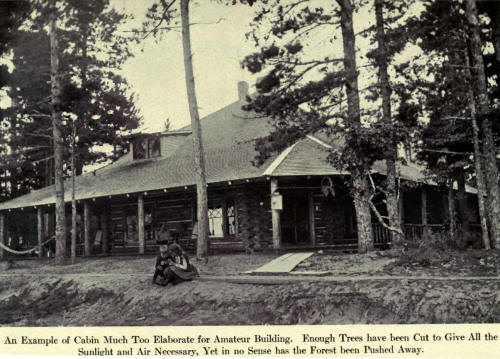
Consider them as frames
for the view, and while many windows are desirable, yet you must not
forget that furniture of a sort must come into the calculation. Many a
room has been built with no space left for the bed. It is commonly said
that a house cannot have too many windows, but a great number of windows
does not necessarily insure the greatest amount of light, nor the best
ventilation. But then again, in the woods, you will be surprised how
dark the surrounding trees will make your camp.
Casement windows lend
themselves very well to our style of architecture, and whenever they are
used, should invariably open out. However, it is almost impossible to
make them wind and stormproof, and they are always ,clashing with the
screens.
Whenever possible, bring
the chimney into the center of the house, to insure a. more even
distribution of the heat, and also make possible the connection from
adjoining rooms with stoves, should the occupancy of the camp in fall or
spring make these desirable.
For a similar reason,
arrange your kitchen so that it can be absolutely shut off from the rest
of the camp when desired. On very warm days in the woods, when the
gentle zephyrs play around the tree tops but forget to come lower down,
you will get the point of this argument. Be sure to look up the regular
sizes of windows and doors that are furnished the trade. from the
factories, so that you can make the proper allowances.
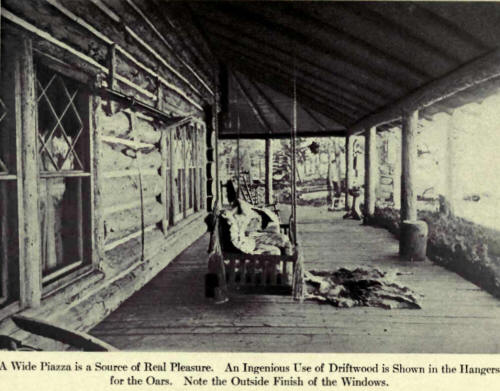
Keeping the building down
to one story will make the labor of construction comparatively easy, and
the care of the house will for the same reason be made much lighter.
This will give you considerable space overhead for storage, or even
sleeping rooms. However, plan to save your living room all the space
clear to the roof. Such an air of largeness and comfort is to be gained
thereby, with the only drawback of a difficulty of heating, though with
even a moderate fireplace a room eighteen by twenty feet, with a
twenty-foot peak, may be kept thoroughly comfortable except in the
bitterest cold of the northern winters.
The veranda will be the
most-used part of the house during the summer season. It should,
therefore, be made generous in its width—ten feet is not too wide—and as
long as conditions will admit of. Thus all the family may occupy it at
one time, and during the very hot days, when eating out-of-doors is a
luxury, it will be turned into a dining room far more attractive than
any you could plan.
On a wide veranda
hammocks may be swung without their excluding large and comfortable
chairs, and here, even on a rainy day, one will scarcely be forced
indoors. But if so, the chances are that the chill dampness will make a
fire desirable. You will not suffer a loss with the exchange.
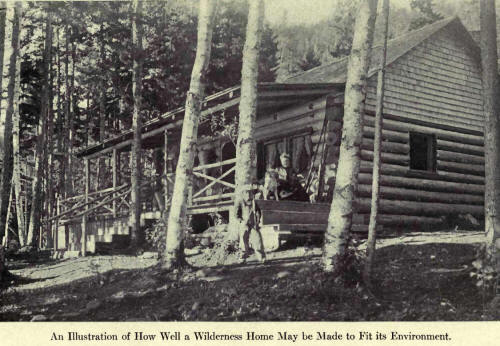
Set the windows of the
sleeping rooms about four feet from the floor. It is curious how much of
an added sense of security and privacy this will give. For there are
those who feel uncomfortable in sleeping for the first time on the
ground floor.
Measure carefully every
inch of the way in your plan, and consider well the utility of every
space; thus you will not find yourself cramped for room, and, on the
other hand, you may save yourself considerable expense of labor and
money.
You are not an architect,
so be modest, and do not strive for architectural effects. Confine
yourself altogether to ascertaining how few rooms you can get along
with, and how to get those rooms to fit into the given space, so that
each one will be large enough to fill the requirements. That is all.
When the plans are
satisfactory, you will make out a list of things required and send your
order for them at the earliest possible moment. Two months before needed
would not be too soon in the South, six weeks in the North and West.
This is not figurative language. I know of what I am speaking. Your list
will look like this:
Number of logs needed.
Number of windows and sizes. (Include if possible frames, finish, and
casings.)
Number of doors and sizes. (Include if possible frames, and finish.)
Amount of lumber for roofing and first floor, also veranda. (This may be
the cheapest grade of spruce, planed on one side.)
Amount of hard pine flooring, two and a half inches wide, planed both
sides.
Number of shingles. (Extra 1, cedar.)
Hinges for various purposes.
Round-headed screws for window casings.
Screws for all the hardware.
Locks.
Window fasteners.
Wire nails. Lath for shingles. Tenpenny for roof and floor boards, etc.
Finish for windows, doors, etc. Spikes for rafters, etc. Eightpenny
floor for flooring.
Building paper.
Creosote stain.
Number of barrels of lime.
Iron supports for fireplace arch.
Sheet lead for chimney.
Sink and short lead pipe for drain.
Firebricks for lining chimney.
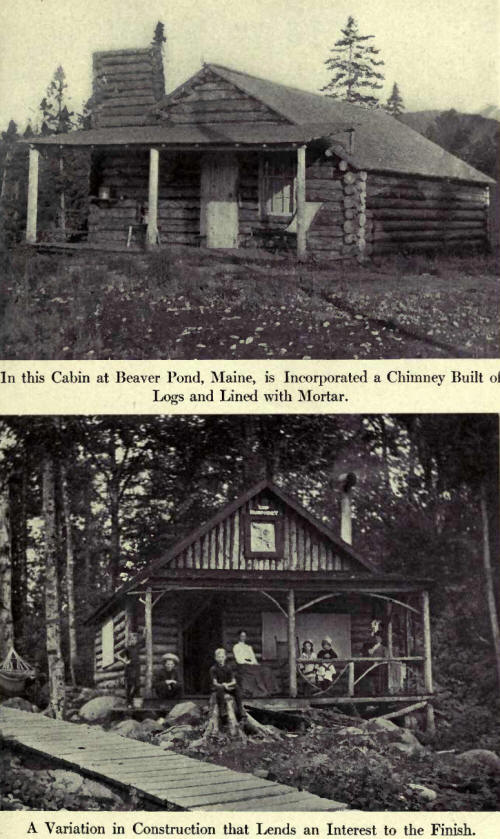
Plans for the smaller
"Hunting Camp" will require much less material than above. However, I
should advise a careful study of your requirements even in this case, so
that time may be saved when you have reached the ground and are ready
for business.
The pitch of the roof is
important, and particularly in regions of heavy snowfall. A fairly steep
roof is therefore desirable, both to lessen the strain and to prevent
the snow water from being backed up under the shingles when a thaw is
followed by a freezing period.
Over the bedrooms and
kitchen, etc., a floor of hard pine, planed on both sides, may be laid,
and this will always give you considerable space in which to stow
things, or, as mentioned elsewhere, may be turned into a sleeping room,
with spaces between the floor and the roof on either side of the room
partitioned off for storage.
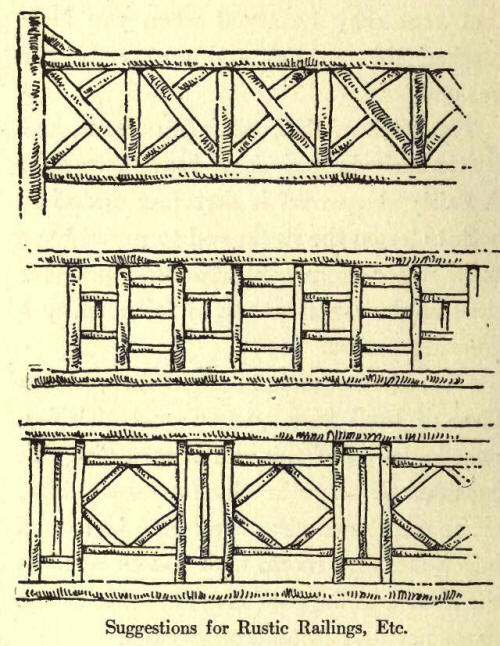
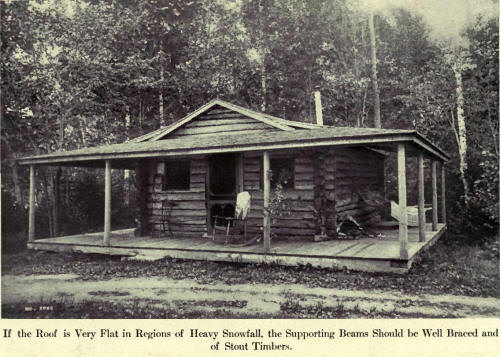
Avoid hip roofs if
possible, though occasionally, in a rather long stretch, they may be
used to lessen the monotony. Try to keep the whole structure under one
continuous roof, for the sake of economy of time and money. The
construction of a hip or a valley roof is not difficult, but they
present features that require care in building that they may be
water-tight and strong.
The matter of rustic
effects in the porch railings, etc., is one allowing a wide latitude to
your inventive faculties, and the entire outside of the camp may be
given a special stamp of individuality by a proper handling. In regions
where white birch may be obtained, one could ask for no finer
decoration. |

